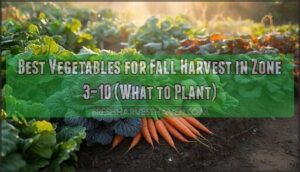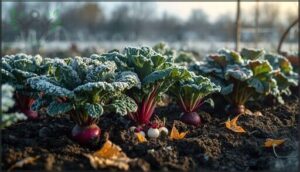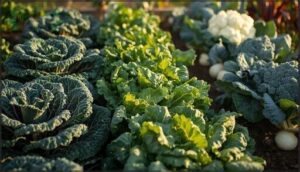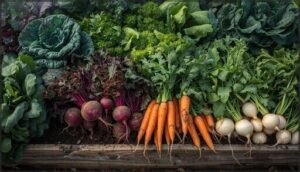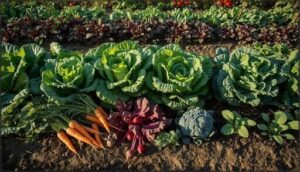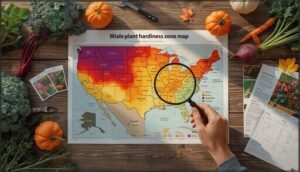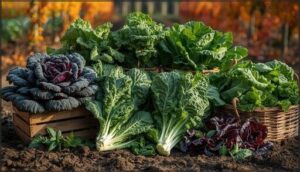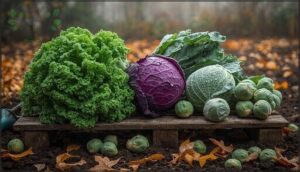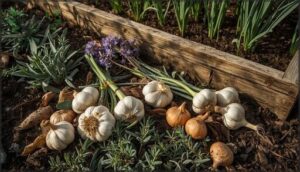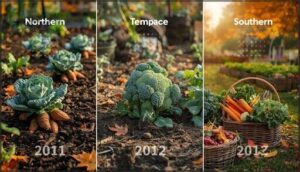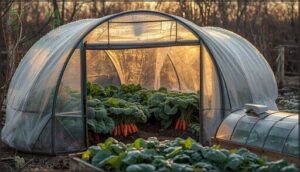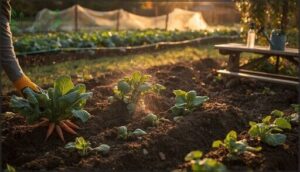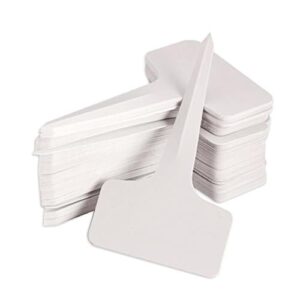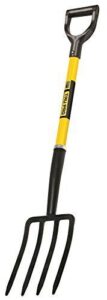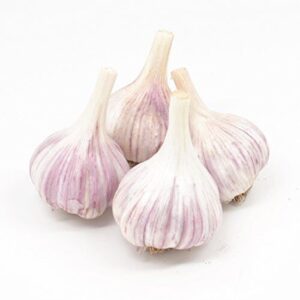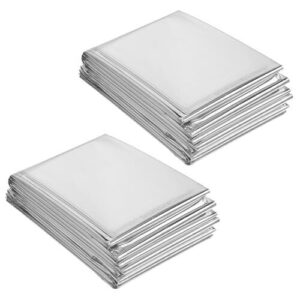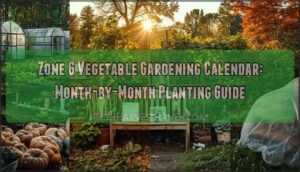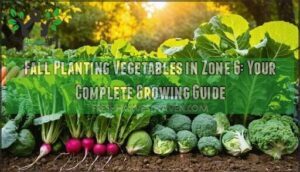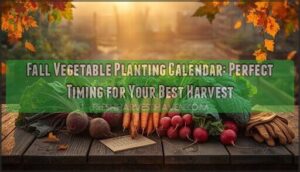This site is supported by our readers. We may earn a commission, at no cost to you, if you purchase through links.
Most gardeners shut down their plots after summer tomatoes fade, but fall might be the smartest growing season you’re ignoring. Cooler temperatures mean fewer pests, less watering, and sweeter-tasting crops—carrots and kale actually develop richer flavors after a light frost nips their leaves.
The challenge isn’t whether you can grow food in autumn; it’s knowing which vegetables match your specific climate zone and when to get them in the ground.
From cold-hardy spinach that survives zone 3 winters to heat-tolerant lettuces thriving in zone 9’s “second spring,” your fall garden can produce fresh harvests well past the first frost if you plant the right crops at the right time.
Table Of Contents
- Key Takeaways
- Best Vegetables for Fall Harvest by Zone
- How to Identify Your Planting Zone
- Top Leafy Greens for Fall Gardens
- Root Vegetables That Thrive in Fall
- Best Brassicas for Cool Weather
- Alliums and Herbs for Autumn Planting
- When to Plant Fall Vegetables by Zone
- Season Extension Tips for Fall Harvests
- Essential Fall Garden Care Strategies
- Top 4 Tools and Supplies for Fall Gardening
- Frequently Asked Questions (FAQs)
- What is the best vegetable to grow in the fall?
- What is the best vegetable to grow in autumn?
- When to plant a fall harvest?
- What can you plant in September in BC?
- When should I start my fall vegetable garden?
- Is September too late to plant fall vegetables?
- How can I prevent frost damage effectively?
- What are good fall herbs to grow?
- Can I grow fall vegetables in containers?
- How to integrate fall crops into crop rotation?
- Conclusion
Key Takeaways
- Your USDA hardiness zone determines which fall vegetables will thrive and when to plant them—cold zones (3-4) need frost-tolerant crops like spinach and kale planted by early August, while warm zones (9-10) can grow both cool-season and warm-season crops simultaneously starting in October.
- Fall crops actually taste better than summer harvests because cooler temperatures mean fewer pests, less watering, and sweeter flavors—carrots and kale develop richer taste after light frost nips their leaves.
- Timing your fall garden requires counting backward from your first frost date and adding 10-14 extra days to account for slower growth in shortened daylight, since most crops stop growing when light drops below 10 hours per day.
- Simple season-extension tools like row covers (providing 2-10°F of frost protection) and 2-4 inches of organic mulch can boost your yields by 30-60% and stretch your harvest window several weeks into winter, even in colder zones.
Best Vegetables for Fall Harvest by Zone
Your growing zone shapes everything about your fall garden—what you can plant, when to sow seeds, and how long your harvest window lasts. Warmer zones enjoy extended growing seasons and mild winters, while colder zones require fast-maturing, frost-tolerant varieties.
Here’s what thrives in each zone during autumn.
Zone 3–4: Cold-Hardy Greens and Roots
In zones 3–4, your fall garden thrives on cold-weather crops that laugh at frost. Start sowing spinach, kale, arugula, and mustard greens in early to mid-August for harvest before the hard freeze hits. These hardy greens selection favorites handle temperatures down to 10°F with basic protection, while root vegetable care gets easier when you plant beets, turnips, and radishes—they’ll sweeten up beautifully after a light frost.
- Spinach survives hoophouse temps to -2°F with row covers
- Kale regrows in spring even if tops freeze
- Beets (like Cylindra) stay harvestable to 12°F
- Turnips tolerate similar cold with minimal cover
For a successful harvest, consider using frost hardy techniques to protect your crops.
Zone 5–6: Versatile Brassicas and Leafy Greens
Moving into zones 5–6, you get more flexibility with fall brassicas and leafy greens. Sow lettuce, spinach, kale, mustard, and collards from late August to early September for harvest before hard freezes. Broccoli and cauliflower transplants thrive when set out during this window—cooler temperatures improve head formation and flavor.
Cool weather crops like kohlrabi and Asian greens fit perfectly into your fall garden planning, with season extension tools pushing harvests into November.
Zone 7–8: Extended Season Greens and Roots
In zones 7–8, your frost-free window stretches into November, giving you real flexibility with fall crop planning and season extension.
Sow leafy greens like lettuce, spinach, kale, arugula, and collards from September into early October for autumn gardening tips that deliver continuous harvests.
Cool season crops such as beets, carrots, and turnips planted in late summer mature beautifully through cool weather crops conditions—many even overwinter in zone 7 gardens with proper root vegetable care.
Zone 9–10: “Second Spring” Crop Options
If you garden in the Deep South or Southwest, fall opens your second spring planting window—possibly your best season for vegetable gardening.
Once October arrives and the heat breaks, you can grow cool-season crops that struggled in summer alongside warm-season holdovers, maximizing crop rotation benefits and fall garden productivity:
- Leafy greens: Lettuce, spinach, kale, Swiss chard (October–November)
- Root crops: Carrots, beets, radishes, turnips (October–early November)
- Brassicas: Broccoli, cabbage, cauliflower (October–November transplants)
- Warm-season crops: Bush beans, cucumbers, tomatoes (September for extended harvest)
- Herbs and alliums: Cilantro, dill, parsley, garlic, onions (October–November)
Your frost-free winters let you practice warm-weather strategies and cool-season crop selection simultaneously—plant successive sowings of radishes every two weeks or interplant fall gardening favorites like kale among late tomatoes for continuous harvests through winter.
How to Identify Your Planting Zone
Before you start planning your fall garden, you need to know which USDA hardiness zone you’re in—it’s the foundation for choosing crops that’ll actually thrive in your area.
Finding your zone takes just a minute or two with the right tools, but understanding what it means for your fall planting schedule makes all the difference. Let’s walk through how to pinpoint your zone and use that information to time your harvest perfectly.
Easy Tools for Finding Your USDA Zone
You don’t need a degree in climatology to find your USDA growing zones—just a ZIP code and thirty seconds. The official USDA hardiness zone map lets you enter your postal code and instantly see whether you’re in Zone 7, Zone 8, Zone 9, or another band.
Gardening apps and online resources like Garden.org pull the same climate data, pairing your hardiness zone with planting calendars, hardiness guides, and zone mapping tools that turn numbers into action.
| Tool Type | Best For |
|---|---|
| USDA interactive map | Precise zone mapping by ZIP code |
| Gardening apps (GrowVeg, Planter) | Mobile-friendly calendars and AI layouts |
| Extension service sites | Localized crop lists and hardiness guides |
Why Zones Matter for Fall Vegetables
Your hardiness zone isn’t just a number—it’s the blueprint for what survives and what shrivels. Frost risk, soil temperature, and growing seasons shift dramatically between Zone 7 and Zone 9, steering every crop selection decision you’ll make.
Your hardiness zone is the blueprint for what survives and what shrivels in your garden
- Zone 8 gardeners can nurse lettuce through November; Zone 3 growers face September cutoffs
- USDA growing zones predict first-frost windows that determine whether your broccoli matures or freezes mid-head
- Climate variability between zones creates 100+ day differences in fall productivity
Adjusting Recommendations for Microclimates
Within your hardiness zone, microclimate analysis matters more than the map suggests. South-facing beds can shift soil temperature half a zone warmer, while frost pockets drop several degrees colder on clear nights—creating climate variability that reshapes crop selection.
Urban gardeners gain extra frost protection and extended harvests, so adjust your cool-season crops and fall garden timing to match these localized conditions, not just the zone number.
Top Leafy Greens for Fall Gardens
Leafy greens are the backbone of any fall garden, and for good reason—they actually prefer the cooler temperatures and shorter days that autumn brings. Most varieties become sweeter after a light frost, making them perfect candidates for planting well into September or even October depending on your zone.
Here’s a closer look at the best leafy greens that’ll keep your fall garden thriving.
Spinach and Lettuce Varieties
Spinach and lettuce stand as your go-to cool-season crops for a reliable fall harvest. Spinach thrives in 50–60°F air temperatures, tolerating lows near 15–20°F, while most lettuce varieties prefer staying above 20°F.
For seed selection, choose savoyed spinach types for cold tolerance and cold-adapted romaine for extended picking.
Harvest timing hinges on backing out 6–10 weeks from your first frost date, ensuring tender greens before winter hits.
Kale, Arugula, and Mustard Greens
Kale, arugula, and mustard greens form the backbone of any fall garden, thriving in crisp 40–65°F days that cool-season crops crave.
Kale nutrition peaks after a few frosts, sweetening leaves naturally, while arugula recipes shine with fast 20–40 day harvests. Mustard benefits from 4–6 week pre-frost plantings, delivering bold flavor.
Start seeds 8–10 weeks before frost for continuous fall harvesting through proper cool-season care.
Swiss Chard and Collard Greens
Swiss chard and collard greens anchor your fall garden with serious cold tolerance—chard produces through frosts until the mid-20s°F, while collards handle 10–12°F. Their nutrient content outshines most greens: collards deliver 141 mg calcium per 100 g.
For fall planting in zones 7–8, seed both crops late August through early September. These cool-season crops reward cut-and-come-again harvest strategies through December.
Root Vegetables That Thrive in Fall
Root vegetables are the workhorses of the fall garden—they improve in flavor after a light frost and store beautifully for months. These underground crops handle cool soil better than most vegetables, making them perfect for planting when summer heat starts to fade.
Here are the top root vegetables you can count on for a reliable fall harvest.
Carrots, Beets, and Turnips
These three root crop benefits champions—carrots, beets, and turnips—give you solid returns in your fall garden. Each cool-season crop stores beautifully and improves with light frost exposure.
What makes them perfect for fall gardening tips:
- Carrots yield 3–5 kg per square meter with proper crop rotation strategies
- Beets deliver folate-rich harvests in 8–10 weeks
- Turnips mature fastest, ready in just 6–8 weeks
- All benefit soil health management through deep root penetration
Plant them mid-July through early September depending on your zone for reliable vegetable storage crops.
Radishes for Quick Harvests
Looking for speed? Radishes deliver the fastest fall harvest among root crops—most radish varieties reach peak size in just 25 to 35 days from fall sowing. Plant these cool-season crops 3/4 inch deep with proper soil preparation and consistent watering for crisp texture.
For your fall garden, try storage types like China Rose, which mature in 50 to 60 days for winter harvest.
Parsnips and Rutabagas for Late Fall
If radishes sprint to the finish, parsnips and rutabagas are your marathon runners—slow but worth the wait. These cold-tolerant root vegetables need 90 to 120 days from sowing to fall harvest, but they actually get sweeter after frost exposure.
Plant parsnip varieties like All-American early in the season, then let rutabaga care take over through autumn’s chill for outstanding winter harvest rewards.
Best Brassicas for Cool Weather
Brassicas are the backbone of any serious fall garden—they don’t just tolerate cool weather, they actually improve in flavor once the temperatures drop.
These heavy feeders appreciate the rich, well-amended soil you’ve been working on all summer, and they’ll reward you with dense, nutrient-packed heads right through the first frosts.
Here’s a look at the best brassicas to plant now for a knockout fall harvest.
Broccoli and Cauliflower
Broccoli and cauliflower are the workhorses of cool-season crops, thriving when daytime highs stay below 75°F. You’ll want to transplant them 60–80 days before your first frost in zones 5–6, and a bit earlier in colder zones.
Here’s your quick-reference fall planting guide:
- Start seeds indoors 6–7 weeks before transplanting
- Space plants 18–24 inches apart in rows
- Time harvest for when temperatures drop consistently
- Expect 45–70 days from transplant to first broccoli harvest
- Store harvested heads at near-freezing temps for best shelf life
Both vegetables pack serious broccoli nutrition—high in vitamin C, fiber, and cancer-fighting compounds—making them excellent choices for fall vegetable gardening for beginners. A little crop rotation between these brassicas can even suppress soil diseases, and their cold tolerance means light frosts actually improve flavor. Perfect for experimenting with new cauliflower recipes all autumn long.
Cabbage Varieties for Fall
Cabbage varieties for fall gardens offer more options than you might expect. For tight harvest windows, ‘Early Golden Acre’ matures in about 60 days, while ‘Copenhagen Market’ delivers 3–4 pound heads in 65–80 days.
Cold-hardy types like ‘January King’ can weather zone 3 lows, and compact ‘Red Acre’ resists splitting during unpredictable fall rains—perfect for intensive Cool Season Crop Selection.
Brussels Sprouts and Kohlrabi
Two standout fall vegetables for cool weather deserve your attention: Brussels sprouts and kohlrabi. Both brassicas excel in fall planting schedules—Brussels sprouts need 90–110 days from transplant, while kohlrabi matures in about 60 days. Proper crop rotation and soil preparation release their brassica benefits across zones 3–10.
- Brussels sprouts improve in flavor after light frosts kiss the stems
- Kohlrabi’s tender bulbs form best between 60–75°F during fall gardening preparation
- Space Brussels sprouts 18–24 inches apart for ideal cool-season crop development
Alliums and Herbs for Autumn Planting
Fall isn’t just about greens and roots—it’s prime time to get garlic, onions, and herbs into the ground. These crops need the cool weather to establish strong root systems before winter, and they’ll reward you with vigorous growth come spring.
Let’s look at which alliums and herbs you should plant now for a head start on next year’s harvest.
Garlic and Onion Sets
Fall planting garlic and onions gives you a head start on next summer’s harvest.
In zones 3–5, plant garlic sets in late September to early October so they establish roots before freeze-up—that cold exposure (vernalization requirements) triggers proper bulb formation. Onion sets need zones 4–8, with added row covers in colder areas.
Choose hardneck garlic varieties for frigid climates, softneck for milder zones.
Chives, Leeks, and Shallots
You’ve already planted your garlic and onions—now round out your allium lineup with chives, leeks, and shallots for an extended cool-season harvest.
Chive varieties thrive in zones 3–9, regrowing vigorously after midsummer cutbacks for continuous fall clipping.
Leeks mature in 70–150 days, making late-summer transplants perfect for winter harvest planning in zones 6–10.
Shallot care includes wider spacing (7 inches) for larger bulbs, and fall planting works beautifully in zones 5–9 with light mulch protecting overwintered sets.
Cold-Tolerant Culinary Herbs
You don’t have to give up fresh flavor when frost arrives—cold hardy herbs like parsley, thyme, and sage handle temperatures well below freezing and keep your fall herb planting productive straight through winter.
- Parsley tolerates air temps down to 10°F with mulch, enabling harvests in zones 5–7 through early winter
- Common thyme survives to zone 4, offering year-round sprigs with minimal herb frost protection
- Sage remains hardy to zone 4–5 when planted in well-drained soil for continuous cool weather gardening
- Cilantro thrives between 50–85°F, making it ideal for fall gardening in zones 6–9
- Rosemary cultivars like ‘Arp’ overwinter in zone 6, supporting herb winterization and reliable culinary herb storage
When to Plant Fall Vegetables by Zone
Timing is critical for fall gardening, and your planting zone is the key to getting it right. The window for sowing seeds shrinks as you move north, and missing it by even a week can mean the difference between a thriving harvest and frost-nipped seedlings.
Here’s how to nail your timing based on where you garden.
Calculating Seeding Dates for Each Zone
Your frost date is the key to perfect harvest timing. Start by finding your zone’s average first frost—then count backward using the crop’s days to maturity, adding 14 extra days for slower late-season growth.
Zones 7–8 can seed greens 8–10 weeks before frost, while zone 9 extends that window.
This backward-counting method turns climate adjustments into precise seeding schedules that actually work.
Factoring in Days to Maturity
Days to maturity on seed packets are your baseline—but you’ll need to add time for fall’s reality. Carrots marked at 70 days actually need closer to 100 in cooler weather, giving roots time to size up properly.
Direct-sown crops count from seeding, while transplants like broccoli count from garden placement. Check whether your packet lists “from transplant” or “from seeding” before calculating your planting window.
Adjusting for Shorter Day Lengths
Once maturity windows are set, you’ll hit the real bottleneck: daylength. When light drops below 10 hours—usually late October in northern zones, late December further south—growth slows dramatically or stops altogether. Here’s how to work around this photoperiod sensitivity:
- Aim for 75% maturity before the 10-hour mark to avoid stalling
- Plant deeper to access consistent soil moisture as growth optimization demands increase
- Use row covers or cold frames for season extension techniques that capture warmth
- Position beds to catch low-angle sun throughout shortened fall days
- Choose frost tolerant plants like mache or claytonia for reliable cool-season gardening
Light supplementation in high tunnels keeps growth active when natural daylight management fails, turning your fall garden preparation into reliable winter harvests.
Season Extension Tips for Fall Harvests
You don’t have to let the first frost end your harvest. With a few simple tools and techniques, you can keep those fall crops producing well into winter—even in colder zones.
Here’s how to stretch your growing season and protect your vegetables when temperatures drop.
Using Row Covers and Cold Frames
When you protect your cool-season crops with row covers or cold frames, you’re creating microclimates that can boost yields by 30–60% while extending your fall harvest window by weeks.
Lightweight row cover materials provide 2°F of frost protection and transmit over 90% of light, while heavyweight fabrics offer 6–10°F of protection—perfect for serious season extension techniques when temperatures drop unexpectedly.
Mulching and Soil Insulation
After you’ve shielded plants from frost with covers, turn your attention to what’s happening beneath the surface. A 2–4 inch layer of organic mulching—straw, wood chips, or compost—stabilizes soil temperature around the clock and can hold soil moisture up to 27% higher than bare ground.
This soil insulation keeps your cool-season crops thriving while buffering against sudden temperature swings common in cold climates.
Planting Deeper for Moisture Retention
When you’re starting fall vegetables, soil moisture management becomes critical—and deeper seeding benefits your crops in ways surface planting can’t match.
Placing seeds 1.5–2 inches down accesses layers that hold stable water, so you’ll see stronger root zone development and less stress during dry spells.
This water conservation strategy is especially effective for cool-season crops facing late-summer heat.
Essential Fall Garden Care Strategies
Getting your fall crops in the ground is just the beginning—the real magic happens in how you care for them once they’re established. Your plants need the right soil conditions, consistent moisture, and protection from seasonal pests to reach their full potential.
Let’s walk through three essential care strategies that’ll help you optimize your fall harvest and keep your garden thriving through cooler weather.
Soil Preparation and Amendments
Your fall soil needs a solid foundation before you plant those cool-season crops. Start with soil testing every few years—it reveals pH, organic matter, and nutrient levels so you’re not guessing.
Incorporate 1–3 inches of compost into the top 6–8 inches using smart tillage methods. If you’re adding manure, apply it months before harvest to boost organic matter safely, especially for gardening in cold climates.
Proper Watering and Moisture Management
Managing water efficiently becomes your secret weapon once day length and evapotranspiration drop through autumn. Cool-season crops need steady soil moisture without overwatering—aim to replace only what the plants use each week.
Here are key strategies to achieve this:
- Install drip irrigation under mulch to reach 90% water efficiency and keep foliage dry.
- Water deeply but less often as temperatures cool, letting the top inch dry between sessions.
- Monitor soil needs by checking moisture 3–4 inches down—fall vegetables hate soggy roots.
- Apply organic mulch like straw or leaves to conserve moisture and moderate soil temperature.
- Adjust frequency downward through autumn; many gardening in cold climates cut irrigation by half compared to summer schedules.
Drip systems paired with mulch benefits deliver excellent results because they match the reduced but steady demand of your fall garden.
Pest and Disease Prevention in Fall
Prevention beats cure every time—clean garden beds now to cut overwintering pests by up to 70%. Remove crop residues and weedy edges, then use row covers as pest barriers for seedlings vulnerable to flea beetles and cutworms.
Rotate cool-season crops to break disease cycles, and consider biological controls like beneficial insects. Proper crop sanitation and companion planting strategies form your first line of defense against fall fungicides dependency.
Top 4 Tools and Supplies for Fall Gardening
Having the right tools on hand makes all the difference when you’re setting up your fall garden. You don’t need a shed full of equipment, but a few well-chosen supplies will help you plant smarter, protect your crops, and keep your beds organized through the season.
Here are four essentials that’ll set you up for success this autumn.
1. Plastic Garden Plant Labels Set
You can’t track what you don’t label—and when you’re juggling multiple fall crops across zones, plastic garden plant labels become your memory in the soil. These durable markers help with plant identification and gardening organization, letting you note varieties, seeding dates, and zone-specific timing at a glance.
Look for UV-resistant label materials that won’t fade through fall rains and cooler temps. Waterproof garden markers support solid fall vegetable garden maintenance and garden planning, especially when succession planting demands precision across different climates and fall gardening tasks.
Best For: Home gardeners and small-scale growers who need an affordable way to track multiple plant varieties, seeding dates, and succession plantings across different garden zones.
- Waterproof and weather-resistant construction holds up through rain and temperature changes during the growing season
- T-shaped design makes them easy to push into soil and reposition as your garden layout changes
- Great value at 100 pieces per pack, giving you plenty of labels for tracking varieties and planting dates across multiple beds
- Some users find them too flimsy for harder or compacted soil, making insertion difficult
- Durability feedback is mixed—while many hold up fine, others report cracking or fading within a single season
- Writing can smear or fade in high-sun conditions unless you use UV-stable permanent markers and let them dry completely
2. Truper Heavy Duty Garden Fork
You won’t get far turning compacted fall beds without a fork that can take real punishment. The Truper Heavy Duty Garden Fork pairs forged steel tines with ash or fiberglass fork handle materials rated to handle around 400 pounds of active load—proven through tool durability tests for heavy-duty gardening.
Its 4-tine design excels at soil turning techniques in clay or root-bound beds, essential when prepping space for cool-season crops.
Solid garden tool maintenance and this fork’s lifetime warranty mean you’ll be planting fall vegetables across climates for years.
Best For: Gardeners tackling heavy-duty fall bed prep in compacted or clay soils who need a fork that won’t bend or break under serious workload.
- Forged steel construction with handles tested to 400 pounds means it handles aggressive soil turning without failing
- 4-tine design gives you the right balance of penetration and leverage for breaking up tough, root-bound fall beds
- Lifetime warranty and durable ash or fiberglass handles keep you working season after season with minimal maintenance
- At nearly 4 pounds, it’s heavier than lighter consumer models and may tire out older users during long sessions
- Some customers report handle breakage despite the warranty, suggesting quality control inconsistencies
- Packaging issues during shipping can lead to bent tines or damage before the fork even reaches you
3. Gourmet Hard Neck Garlic Bulbs
Once your beds are ready, grab a pack of gourmet hardneck garlic varieties—Chesnok Red is a standout for cold climate gardening.
Hardneck garlic care is straightforward: plant individual cloves 6 inches apart and 6 inches deep in fall, mulch well, and you’re set for a summer harvest. Each bulb yields 5 to 10 plantable cloves, and proper garlic planting tips pay off with 4 to 7 pounds of harvest per pound planted—core fall harvest strategies for cool-season crops across zones.
Best For: Home gardeners in cold climates (zones 3-6) who want a flavorful, easy-to-grow fall-planted garlic with large cloves for cooking.
- Thrives in freezing temperatures down to -30°F and produces 4-7 pounds of harvest per pound planted with minimal maintenance
- Large individual cloves (5-10 per bulb) make peeling and cooking easier compared to softneck varieties with smaller cloves
- Rich, complex flavor that’s prized in gourmet cooking, plus the satisfying hardneck scape harvest in early summer
- Shorter storage life of 4-6 months compared to softneck garlic that can last up to a year
- Customer reviews mention inconsistent quality with some bulbs arriving rotten, undersized, or failing to sprout
- Lower yield per pound of seed (4-7 lbs) compared to softneck types (6-10 lbs), making it less productive for large-scale growing
4. Silver Reflective Garden Foil Sheets
After planting garlic, boost light for your cool-season crops with silver reflective foil sheets—a simple upgrade for garden light optimization.
Lay these 83×52-inch sheets around fall vegetables to reflect up to 95% of sunlight back into lower leaves, increasing yield by up to 20% in peppers and advancing harvest by 7–10 days.
Reflective mulching also cuts aphid numbers by 96% and lowers virus incidence 85% while managing soil temperature and moisture.
Foil durability testing shows they handle fall gardening tasks across climates, folding flat for storage between seasons.
Best For: Gardeners who want to boost cool-season crop yields and cut pest pressure without chemicals, especially if you’re growing vegetables like peppers, cucumbers, or squash in beds or grow rooms.
- Reflects up to 95% of sunlight back into plants, which studies show can increase yields by 20% and speed up harvest by a week or more
- Cuts aphid populations by 96% and slashes virus spread by 85%, giving you natural pest control without sprays
- Lightweight, foldable, and easy to install with adhesive tape—just lay flat around your plants and secure the edges
- Won’t hold up well in extreme weather or fully exposed outdoor conditions, so it’s better for covered or protected areas
- Needs careful handling and storage since foil can tear or crease if you’re not gentle with it
- May not work for every plant type or setup, and you’ll need to install it properly to actually see the benefits
Frequently Asked Questions (FAQs)
What is the best vegetable to grow in the fall?
Leafy greens like spinach and kale top the list for fall vegetables—they mature fast, tolerate frost beautifully, and deliver outstanding nutrition.
Cool-season crops thrive when warm-season plants fade, making fall gardening incredibly rewarding.
What is the best vegetable to grow in autumn?
Like choosing the right jacket for autumn weather, your best fall crop selection depends on your zone—but spinach, kale, and carrots consistently deliver reliable vegetable yields across zones 3–10 with proper seasonal planting timing.
When to plant a fall harvest?
Count backward from your first frost date—subtract the crop’s days to maturity plus 10–14 days for slower fall growth. In Zone 6, that means August sowings for October harvests.
What can you plant in September in BC?
British Columbia’s coastal climate creates a second chance for cool-season crops in September.
Sow kale, lettuce, spinach, arugula, Swiss chard, beets, radishes, carrots, and sugar snap peas for productive fall harvests through November.
When should I start my fall vegetable garden?
Start your fall garden 10–12 weeks before your first frost date for most cool-season crops. Add two extra weeks to account for slower growth as days shorten—that timing shift makes all the difference in successful fall planting and garden planning.
Is September too late to plant fall vegetables?
September’s window of opportunity hasn’t closed yet—though it narrows depending on your zone.
In warmer regions (7–10), you’ll still harvest cool-season crops. Northern gardeners need fast-maturing varieties and row covers for success.
How can I prevent frost damage effectively?
You’ll need floating row covers (providing 2–4°F protection), cold frames for extended season buffering, and strategic mulching around roots.
Time plantings to mature before your frost date, reserving covers for occasional freeze nights rather than continuous use.
What are good fall herbs to grow?
Oh, you’ll only plant basil and dill? Good luck with that funeral.
For actual survivors, try thyme, sage, oregano, and chives—perennial powerhouses hardy to zone Parsley, cilantro, and cold-season crops laugh at frost.
Can I grow fall vegetables in containers?
Yes, you can grow fall vegetables in containers using proper container soil and drainage. Small space gardening works well for cool-season crops like lettuce, spinach, and radishes—ideal for portable gardens and season extension on patios.
For best growth, it’s vital to think about the container gardening tips.
How to integrate fall crops into crop rotation?
Rotating heavy feeders like tomatoes away from beds designated for fall brassicas can cut your fertilizer needs by up to 50%.
Follow legumes with nutrient-hungry greens, then roots, cycling crop families through separate beds every four years.
Conclusion
Your fall garden doesn’t need guesswork—it needs the right crops matched to your climate. Whether you’re nursing cold-hardy kale through zone 4 frosts or planting heat-loving lettuce in zone 9’s cooler months, the best vegetables for fall harvest in zone-specific gardens thrive when timing aligns with temperature.
Start seeds six to eight weeks before your first frost, prep soil with compost, and watch your autumn plot outperform summer’s harvest. Fall gardening isn’t luck—it’s strategy.
- https://fromsoiltosoul.ca/what-to-plant-in-a-zone-3-fall-garden/
- https://homelyhens.com/vegetable-gardening/what-to-plant-in-a-fall-garden/
- https://www.sustainablemarketfarming.com/2021/04/14/winter-kill-temperatures-of-cold-hardy-vegetables-2021/
- https://www.theseasonalhomestead.com/top-15-cold-tolerant-vegetables-for-fall-amp-winter-gardening/
- https://www.seedsnow.com/blogs/news/47143105-19-frost-hardy-vegetables-to-plant-this-fall

